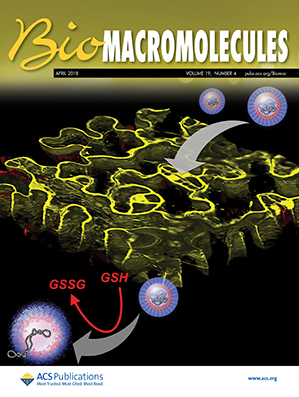Chitosan-Based Thermal-Coagulation Hydrogel System Driven by Multiple Interactions: Oxidation-Induced Fast Gelation and Enhanced Performance
IF 5.5
2区 化学
Q1 BIOCHEMISTRY & MOLECULAR BIOLOGY
引用次数: 0
Abstract
The application of the chitosan/β-glycerophosphate (CS/β-GP) system is limited due to its weak mechanical performance, high concentration of β-GP, and slow gelation. To revitalize this thermal-coagulation system, we used catechol-chitosan (CS-C) and systematically investigated the influence of modification. By controlling the grafting rate, it was found that the solution pH and pK a of CS-C were both affected by the decrease of the amino groups, whereas the gelation time and the required β-GP content for gelling significantly decreased. Using the oxidative properties of the catechol groups, the CS-C/β-GP hydrogel showed a 10-fold increment in stiffness, rapid gelation (1–2 min), and a much lower β-GP content (2–6 wt %). In addition, the hydrogel performed well in antimicrobial and biocompatibility tests. This is the first work to elucidate the thermal-coagulation mechanism of modified chitosan systems, making the application of chitosan-based thermal-coagulation systems in the field of biomedicine and tissue repair possible.
- Download: Download high-res image (256KB)
- Download: Download full-size image
基于壳聚糖的多重相互作用驱动的热凝水凝胶体系:氧化诱导的快速凝胶化和性能增强。
壳聚糖/β-甘油磷酸酯(CS/β-GP)体系由于其力学性能弱、β-GP浓度高、凝胶化慢等缺点,限制了其应用。为了活化这一热凝体系,我们使用了儿茶酚壳聚糖(CS-C),并系统地研究了改性的影响。通过控制接枝速率,发现CS-C的溶液pH和pKa均受氨基减少的影响,而胶凝时间和胶凝所需的β-GP含量均显著降低。利用邻苯二酚基团的氧化特性,CS-C/β-GP水凝胶的硬度增加了10倍,凝胶化速度快(1-2分钟),β-GP含量低得多(2-6 wt %)。此外,水凝胶在抗菌和生物相容性试验中表现良好。本研究首次阐明了改性壳聚糖体系的热凝机理,为壳聚糖基热凝体系在生物医学和组织修复领域的应用提供了可能。
本文章由计算机程序翻译,如有差异,请以英文原文为准。
求助全文
约1分钟内获得全文
求助全文
来源期刊

Biomacromolecules
化学-高分子科学
CiteScore
10.60
自引率
4.80%
发文量
417
审稿时长
1.6 months
期刊介绍:
Biomacromolecules is a leading forum for the dissemination of cutting-edge research at the interface of polymer science and biology. Submissions to Biomacromolecules should contain strong elements of innovation in terms of macromolecular design, synthesis and characterization, or in the application of polymer materials to biology and medicine.
Topics covered by Biomacromolecules include, but are not exclusively limited to: sustainable polymers, polymers based on natural and renewable resources, degradable polymers, polymer conjugates, polymeric drugs, polymers in biocatalysis, biomacromolecular assembly, biomimetic polymers, polymer-biomineral hybrids, biomimetic-polymer processing, polymer recycling, bioactive polymer surfaces, original polymer design for biomedical applications such as immunotherapy, drug delivery, gene delivery, antimicrobial applications, diagnostic imaging and biosensing, polymers in tissue engineering and regenerative medicine, polymeric scaffolds and hydrogels for cell culture and delivery.
 求助内容:
求助内容: 应助结果提醒方式:
应助结果提醒方式:


